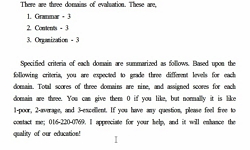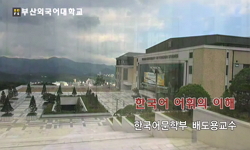This thesis mainly studies the Sino-Korean word with the highest proportion in the Korean vocabulary system, and proposes a Sino-Korean word education program for non-Chinese cultural circles. Although many scholars have proposed the education program...
http://chineseinput.net/에서 pinyin(병음)방식으로 중국어를 변환할 수 있습니다.
변환된 중국어를 복사하여 사용하시면 됩니다.
- 中文 을 입력하시려면 zhongwen을 입력하시고 space를누르시면됩니다.
- 北京 을 입력하시려면 beijing을 입력하시고 space를 누르시면 됩니다.

비한자문화권 초급 학습자를 위한 한자어 교육 방안 연구 - TOPIK 초급 한자어를 중심으로 = A Study on Sino-Korean Word Education Program for Elementary Learners in Non-Chinese Character Culture Circle - Focusing on TOPIK primary Sino-Korean word
한글로보기https://www.riss.kr/link?id=A106488555
- 저자
- 발행기관
- 학술지명
- 권호사항
-
발행연도
2019
-
작성언어
Korean
- 주제어
-
등재정보
KCI등재
-
자료형태
학술저널
- 발행기관 URL
-
수록면
203-242(40쪽)
-
KCI 피인용횟수
0
- DOI식별코드
- 제공처
- 소장기관
-
0
상세조회 -
0
다운로드
부가정보
다국어 초록 (Multilingual Abstract)
This thesis mainly studies the Sino-Korean word with the highest proportion in the Korean vocabulary system, and proposes a Sino-Korean word education program for non-Chinese cultural circles. Although many scholars have proposed the education programs of Sino-Korean word for Korean learners who are not in the Chinese cultural circle, most of them advocate that learners who have no Chinese knowledge should learn Chinese characters first before learning Sino-Korean word. In the field of Korean language education, the idea of learning Chinese characters to learn learning Sino-Korean runs counter to the original intention of learners to learn Korean. Therefore, this thesis argues that there is only necessary to use the relevance of Sino-Korean word and Chinese characters to learn Sino-Korean word, while the learning of Chinese characters is not essential. That is to say,in the process of learning a Sino-Korean word, the learner can achieve the learning of both the Sino-Korean word and the pure-Korean word by marking each individual character that constitutes a Sino-Korean word and its unique meaning with an pure-Korean word, which also helps to improve the Korean vocabulary.
First, the vocabulary catalogue provided by the Korean Language Proficiency Test(TOPIK) was used as the basis, and the Sino-Korean words that the learners must master in the primary stage were selected. The selected Sino-Korean words were then parsed in units of words. That is to say, for each word and its corresponding meaning, the associated Sino-Korean word in units of words, difficulty and importance are collated and analyzed. And an analysis of the proportion of associated Sino-Korean word and corresponding meanings. Through the calculation, the individual character with the proportion of 2 points or more and its associated Sino-Korean word characters were selected for detailed analysis. Based on this, A specific preliminary Sino-Korean word education program and learning model for Korean learners in the non-Chinese character circle were proposed. The new attempt put forward in this thesis can be used to study the characteristics of Sino-Korean word, the meaning of individual character, the intrinsic words and the Sino-Korean word in the process of learning Sino-Korean word in non-Chinese character culture circles, Which may have a very significant meaning in the Korean language education field.
국문 초록 (Abstract)
본고에서는 한국어 어휘 체계 중 가장 큰 비중을 차지하고 있는 한자어의 필요성을 인지함으로써 비한자문화권 초급 한국어 학습자를 위한 한자어 교육 방안을 제시하였다. 기존 연구에서 ...
본고에서는 한국어 어휘 체계 중 가장 큰 비중을 차지하고 있는 한자어의 필요성을 인지함으로써 비한자문화권 초급 한국어 학습자를 위한 한자어 교육 방안을 제시하였다. 기존 연구에서 일부 학자들이 비한자문화권 한국어 학습자를 위한 한자어 교육 방안을 제시하였지만 한자어와 한자의 연관성을 고려하여 한자 지식이 전혀 없는 학습자들에게 한자를 우선적으로 가르쳐야 한다는 연구가 많았다. 그러나 본고에서는 초급 한국어 학습자들에게 한자어를 배우기 위해 한자부터 학습하는 것은 매우 어려운 현실이기 때문에 기존 한자어 교육 방법과 달리 한자어와 한자의 연관성을 활용하는 새로운 교육 방안을 고찰하였다. 우선 한국어능력시험(TOPIK)에서 제시된 초급 어휘 목록을 추출하고, 초급 단계에서 학습자가 학습해야 할 한자어를 선정하였다. 다음으로 선정된 한자어를 단자(單字) 단위로 이에 대응된 각각의 의미의 양상을 분석하였다. 즉 단자와 이에 대응된 의미, 관련된 한자어, 난이도, 중요도에 따라 분석 정리하고, 이와 관련된 한자어와 대응 의미의 비율을 고찰하였다. 그리고 점수를 산정하여 2점 이상의 단자와 이에 대응된 한자어를 구체적으로 분석하여 비한자문화권 학습자를 위한 초급 한자어 교수·학습 모형과 이를 적용한 교육 방안을 제시하였다. 본고에서 제시한 새로운 시도가 한자어를 학습하는 과정에서 한자의 특성, 단자의 의미 파악, 고유어 및 한자어를 통합적으로 학습할 수 있다는 점에서 본고의 의의가 있다고 본다.
참고문헌 (Reference)
1 정호성, "표준국어대사전수록 정보의 통계적 분석" 국립국어원 10 (10): 6-7, 2000
2 "표준국어대사전" 국립국어원 1999
3 토픽, "토픽 어휘 공개 목록(초급)"
4 김경옥, "중등교육에서의 한자어 이해도 연구" 淑明女子大學校 敎育大學院 1999
5 馬今善, "중국인 한국어 학습자를 위한 한자어 교육 연구" 서울대학교 대학원 2012
6 이박문, "중국인 학습자를 위한 초급 한자어 분석 및 교육 연구" 인하대학교 대학원 2018
7 박덕유, "이해하기 쉬운 문법교육론" 역락출판사 2017
8 이영희, "외국인을 위한 한자어 교육 연구" 숙명여자대학교 대학원 2008
9 박덕유, "외국인 학습자를 위한 어휘력 신장 연구(I) - 한국어 漢字 및 漢字語를 중심으로 -" 한국언어문화교육학회 5 (5): 85-104, 2009
10 韓在永, "外國語로서의 韓國語 漢字敎育을 위한 기초적 연구-非漢字文化圈 학습자를 對象으로-" 한국어문교육연구회 31 (31): 557-586, 2003
1 정호성, "표준국어대사전수록 정보의 통계적 분석" 국립국어원 10 (10): 6-7, 2000
2 "표준국어대사전" 국립국어원 1999
3 토픽, "토픽 어휘 공개 목록(초급)"
4 김경옥, "중등교육에서의 한자어 이해도 연구" 淑明女子大學校 敎育大學院 1999
5 馬今善, "중국인 한국어 학습자를 위한 한자어 교육 연구" 서울대학교 대학원 2012
6 이박문, "중국인 학습자를 위한 초급 한자어 분석 및 교육 연구" 인하대학교 대학원 2018
7 박덕유, "이해하기 쉬운 문법교육론" 역락출판사 2017
8 이영희, "외국인을 위한 한자어 교육 연구" 숙명여자대학교 대학원 2008
9 박덕유, "외국인 학습자를 위한 어휘력 신장 연구(I) - 한국어 漢字 및 漢字語를 중심으로 -" 한국언어문화교육학회 5 (5): 85-104, 2009
10 韓在永, "外國語로서의 韓國語 漢字敎育을 위한 기초적 연구-非漢字文化圈 학습자를 對象으로-" 한국어문교육연구회 31 (31): 557-586, 2003
11 최상진김진해, "北韓 ‘말다듬기 사업’의 漢字語 관련 對應語 연구" 한국어문교육연구회 34 (34): 41-68, 2006
동일학술지(권/호) 다른 논문
-
- 어문연구학회
- 사은영
- 2019
- KCI등재
-
<제주도(濟州道) 기행(紀行)>과 <제주여행가>의 작품 실상과 현대적 의미
- 어문연구학회
- 김기영
- 2019
- KCI등재
-
- 어문연구학회
- 박종익
- 2019
- KCI등재
-
이공계 글쓰기 수업의 문제점 및 개선 방안 - 충남대학교 <공학논문작성과 발표> 강좌를 중심으로
- 어문연구학회
- 조규찬
- 2019
- KCI등재
분석정보
인용정보 인용지수 설명보기
학술지 이력
| 연월일 | 이력구분 | 이력상세 | 등재구분 |
|---|---|---|---|
| 2026 | 평가예정 | 재인증평가 신청대상 (재인증) | |
| 2020-01-01 | 평가 | 등재학술지 유지 (재인증) |  |
| 2017-01-01 | 평가 | 등재학술지 유지 (계속평가) |  |
| 2013-01-01 | 평가 | 등재학술지 유지 (등재유지) |  |
| 2010-01-01 | 평가 | 등재학술지 유지 (등재유지) |  |
| 2008-01-01 | 평가 | 등재학술지 유지 (등재유지) |  |
| 2006-06-30 | 학술지명변경 | 외국어명 : 미등록 -> EOMUNYEONGU |  |
| 2006-01-01 | 평가 | 등재학술지 유지 (등재유지) |  |
| 2003-01-01 | 평가 | 등재학술지 선정 (등재후보2차) |  |
| 2002-01-01 | 평가 | 등재후보 1차 PASS (등재후보1차) |  |
| 2000-07-01 | 평가 | 등재후보학술지 선정 (신규평가) |  |
학술지 인용정보
| 기준연도 | WOS-KCI 통합IF(2년) | KCIF(2년) | KCIF(3년) |
|---|---|---|---|
| 2016 | 0.35 | 0.35 | 0.38 |
| KCIF(4년) | KCIF(5년) | 중심성지수(3년) | 즉시성지수 |
| 0.47 | 0.43 | 0.724 | 0.11 |





 KCI
KCI 스콜라
스콜라







